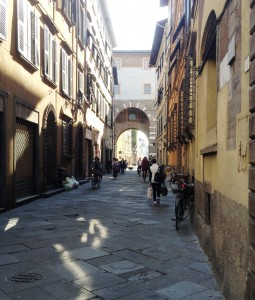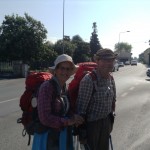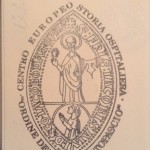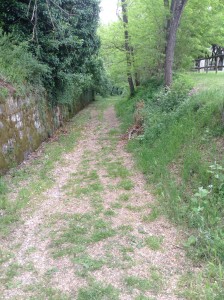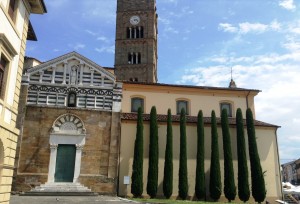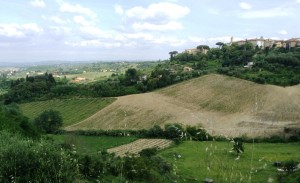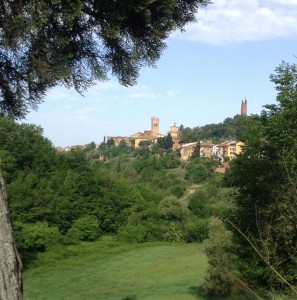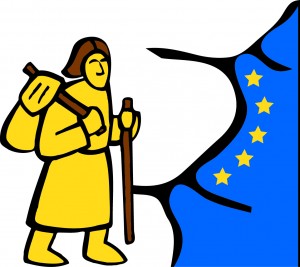 Between May the 7th and May the 15th, and in honour of lost friends, relatives and pets we made a spiritual journey on Europe’s most famous walking route after the Camino di Santiago; The Via Francigena from Canterbury to Rome. (Please see previous post) At least we tackled the 140 kilometer section from Lucca to Siena in the heart of the region of Tuscany. It was a journey of friendship, of good health and of recognition of those that have died in the past year. It was also a profound connection of our feet on the earth of this most beautiful land, of castles, flowers and the people of Europe. So important in these most concerning of times, when we witness the profound miseries of conflict, displacement and migration. The Via Francigena was all about travel across a continent in the name of meeting others in the world with the aim of companionship, exploration and spiritual/personal fulfillment.
Between May the 7th and May the 15th, and in honour of lost friends, relatives and pets we made a spiritual journey on Europe’s most famous walking route after the Camino di Santiago; The Via Francigena from Canterbury to Rome. (Please see previous post) At least we tackled the 140 kilometer section from Lucca to Siena in the heart of the region of Tuscany. It was a journey of friendship, of good health and of recognition of those that have died in the past year. It was also a profound connection of our feet on the earth of this most beautiful land, of castles, flowers and the people of Europe. So important in these most concerning of times, when we witness the profound miseries of conflict, displacement and migration. The Via Francigena was all about travel across a continent in the name of meeting others in the world with the aim of companionship, exploration and spiritual/personal fulfillment.
Days One to Three – Lucca to San Miniato – Lanes, rivers and meadows
There is always a buzz about beginning an adventure like this one, especially when you leave a place as magnificent as Lucca on a Saturday morning with it’s buzz of people; weaving on bikes, walking around the market, seeing the tourist, maps and guides in hand losing themselves among the ancient narrow streets. Today, in brilliant sunshine, it is fantastic walking along the road out of town and out of Porta Elisa headed for Siena in a week’s time. We were wondering whether we would see another traveler along the way, but within a few meters of the fat red walls of Lucca we meet two French walkers on their way to Rome from their home in France in one continuous journey. Still as full of joy and pleasure as we are even after traversing Switzerland and the Alps……we are just beginners I think!
Out through the suburbs of the city and across the plain to Altopascio. Here the joy is that local people are tending their suburban gardens, already full of tomato plants, artichokes and salad. The jasmine is in full perfume in the hedges, the people so friendly to passers by and wishing us a ‘Boun Viaggo’. This is the slow way to grow food and the slow and fruitful way to make a journey. 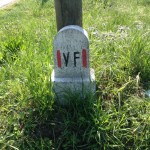
These are the signs that keep us on track, the sign says to us ‘Very Friendly’, they are regular sentries on the footpath that tell us we are where we belong and where we need to be; on the road that will be a joy and a delight to us and will hopefully take us to special places. Altopascio is the end of day one and has a very old church and hostel for pilgrims at it’s centre. It also has the most fantastic ‘Timbro’. A Timbro is a stamp that says you have completed a stage of the Via Francigena successfully and you can put it into your ‘Credenziali’, your book detailing your journey from wherever you start to whenever you arrive in Rome. If you complete this book with its stamps and you begin at least 100 kms from Rome you are officially a Pilgrim to Rome. The next day we continue our journey from Altopascio to Ponte a Cappiano, through meadows and along streams. Here the VF is quiet and somehow a little lonely. A small chapel here, and through quiet woods there. We spend a little time walking on a piece of road that is cobbled and is the original 13th century road to Rome. You can almost see and hear the carts and horses rattling along the stones, the ancestors in their medieval clothes, with their loads of merchandise for the next town, or their worldly goods as they travel to somewhere new, ancient refugees from a plague or another war perhaps.
Here too as we head to Ponte Cappiano the scenery changes. Across the ‘spooky’ woods’ of a ancient heathland called ‘The Sammartina’ (the land of the lost). For those without the VF signs on the route, you can imagine being lost among these small woods. We then trek down to the village surrounded by lovely villas. The town of Cappiano gets its name from the covered bridge that crosses a river here. The walk from here the next day runs along side the watery meadow and swamp land of the plain below San Miniato. We accompanied on our walk by the distinctive raucous bellows of the mating frogs in the little ditches below our feet. We notice the fields of wheat and wild flowers as we climb up to Fuccechio for lunch in the square. We then climb up to the familiar serpent length of San Miniato, by now we have walked 50 kilometres, and begin to look beyond to the famous Tuscan Hills of the Val d’Elsa and Chianti hills.

